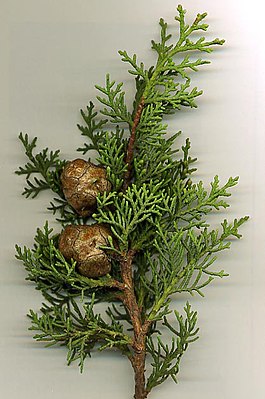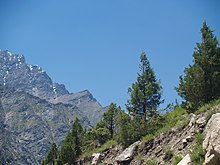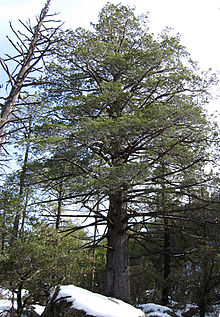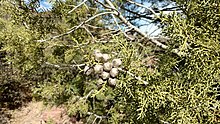Cypress trees
| Cypress trees | ||||||||||||
|---|---|---|---|---|---|---|---|---|---|---|---|---|

Branch with cones of the |
||||||||||||
| Systematics | ||||||||||||
|
||||||||||||
| Scientific name | ||||||||||||
| Cupressus | ||||||||||||
| L. |
The cypress ( Cupressus ) are a genus within the family of the cypress family (Cupressaceae). In some landscapes the cypresses are characteristic of the cultural landscape, for example the Mediterranean cypress in Tuscany .
description



Vegetative characteristics
Cupressus species are evergreen, woody plants that grow as trees or shrubs . The growth forms of the cypress species and cultivars vary from dwarfed to tall, from hanging to columnar, from high-crowned to expansive. Their rapid growth and dense foliage make them a suitable windbreak. Seedlings have (two to five cotyledons cotyledons ).
The scale-like leaves are cross-opposite in four rows on the branches.
Generative characteristics
Cupressus species are monoecious and separate sexes ( monoecious ), i.e. they form male and female cones on one specimen. The male cones have four to ten pairs of sporophylls . Each sporophyll carries three to ten pollen sacs . The female spherical to egg-shaped cones take about two years to mature, but they often remain closed for many years before they open when exposed to fire. The 8 to 43 millimeter large cones usually have three to six (two to seven) pairs of thick, woody cone scales. Each cone scale bears 3 to 20 seeds, depending on the species. The seeds have two wings.










history
The 12 to 15 million year old find of a Taxodioxylon germanicum , close relative of Taxodium distichum , in the Garzweiler open-cast lignite mine documents the occurrence of cypresses there during the Miocene .
After the glaciation of the Holocene receded , cypresses are said to have been brought back to Europe from Asia by the Phoenicians and first planted in Cyprus. In ancient mythology , the cypress is a symbol and attribute of many deities, it stands for the underworld, symbolizes longevity and has always been associated with death and mourning. Like many evergreen plants, it is used as an expression of grief for cemetery planting.
Mediterranean cypress trees ( Cupressus sempervirens ) have been cultivated since ancient times . As the botanical name of the species suggests, they are evergreen conifers ( sempervirens means "evergreen") that grow rapidly in their youth and slower with age. The species assigned to the genus and their numerous cultivated forms can only tolerate cold to a limited extent.
In the Mediterranean and Western Asia , it is difficult to distinguish which species were originally here: Cypress species were already planted in different locations during the Roman Empire .
Systematics, botanical history and distribution
The genus Cupressus was established by Carl von Linné . The generic name Cupressus is derived from the Greek word κυπαρισσος kyparissos .
Cupressus species are found in all warm climates of the northern hemisphere , such as western North America and Central America , northwest Africa , the Middle East , the Himalayas , southern China and northern Vietnam .
The number of species assigned to this genus Cupressus varies from 16 to 33, depending on the author. Most populations are very small and isolated and it is difficult to distinguish whether an individual population is to be classified as a species or a sub- taxon . Some authors only place the species of the Old World, i.e. those of the subgenus Cupressus , in the genus Cupressus s. st. Adams, Bartel & Price placed the species of the New World in the new genus Hesperocyparis in 2009 .
The genus Cupressus s. l. is divided into four sub-genera and contains about 25 species:
- Subgenus Cupressus :
- Cashmere cypress ( Cupressus cashmeriana Royle ex Carrière , Syn .: Cupressus pendula Griffin non Thunb. , Cupressus torulosa Griffin , Cupressus corneyana Carrière , Cupressus torulosa var. Cashmeriana (Royle ex Carrière) Kent , Cupressus himalaica Silba , Cupressus himalaensis var .ba dareelingis , Cupressus darjeelingensis (Silba) Silba , Cupressus assamica Silba , Cupressus pseudohimalaica Silba ): It occurs in Bhutan and in the Indian state of Arunachal Pradesh . It was planted near temples in eastern Nepal, Sikkim, and Tibet.
-
Cupressus chengiana S.Y.Hu : There are two varieties :
- Cupressus chengiana S.Y.Hu . Var chengiana (syn .: Cupressus fallax Franco , cupressus chengiana var. Kansouensis Silba , cupressus chengiana var. Wehchuanhsiensis Silba ): It grows on mountain slopes and in valleys at altitudes from 900 to 2,900 meters in the Chinese provinces of southern Gansu and northern and western Sichuan .
- Cupressus chengiana var. Jiangensis (N.Zhao) Silba (Syn .: Cupressus jiangensis N.Zhao ): This endemic thrives at altitudes of around 800 meters only in Jiange Xian in northern Sichuan.
- Yunnan cypress ( Cupressus duclouxiana Hickel ex A.Camus , Syn .: Cupressus sempervirens Franch. Non L. , Cupressus austrotibetica Silba ): It thrives in forests on mountain slopes at altitudes of 1400 to 3300 meters in southeastern Tibet and in the southwestern Chinese provinces Sichuan, central to northwestern Yunnan and maybe in Guizhou. It is used as an ornamental plant.
-
Cupressus dupreziana A. Camus : There are two varieties:
- Atlas cypress ( Cupressus dupreziana var. Atlantica (Gaussen) Silba , syn .: Cupressus atlantica Gaussen ): This endemic grows on rocky slopes on limestone and sandy banks of rivers in open scrub vegetation or degraded forest land in the High Atlas Mountains in southern Morocco (11 ° W, 31 ° N).
- Saharan Cypress Tamrit cypress ( Cupressus dupreziana A.Camus . Var dupreziana , Cupressus lereddii Gaussen , Cupressus sempervirens var. Dupreziana (A.Camus) Silba ): This endemic thrives in altitudes from 1000 to 1800 meters only at the southwestern border of Edeni or Tamrit Plateau of the Tassili N'Ajjer Massif in the central Sahara (9 ° E 25 ° N) only in Algeria . In 2002 only 233 flowering specimens were found. Together with the Sahara myrtle, they form a sparse tree population, 300 km away from the nearest tree population. The few specimens are part of the UNESCO - World Heritage and strongly threatened Tassili n'Ajjer extinction.
- Weeping cypress ( Cupressus funebris Endl. , Syn .: Chamaecyparis funebris (Endl.) Franco , Cupressus funebris var. Gracilis Carriere ): It thrives at altitudes below 2000 meters in the Chinese provinces of Anhui , Fujian , Gansu , northern Guangdong , northern Guangxi , eastern Guizhou , Henan , western Hubei , Hunan , Jiangxi , Shaanxi , Sichuan, Yunnan and Zhejiang . It is cultivated in southern China.
- Tibetan cypress ( Cupressus gigantea W.C.Cheng & LKFu , Syn .: Cupressus torulosa var. Gigantea (WCCheng & LKFu) Farjon ): This endemic thrives on mountain slopes and along rivers at altitudes of 3000 to 3400 meters only at a few sites in southeastern Tibet .
- Mediterranean cypress , Italian cypress, Real cypress ( Cupressus sempervirens L. , Syn .: Cupressus horizontalis Mill. , Cupressus patula Spadoni , Cupressus horizontalis var. Pendula hort. Ex Endl. , Cupressus sempervirens subsp. Horizontalis (Mill.) A.Camus , Cupressus sempervirens var. horizontalis (Mill.) Loudon , Cupressus sempervirens var. numidica trot. ): Since this type is cultivated for so long is their original distribution area not known for their area could from the eastern Mediterranean (Greek islands and Turkey) to Syria and northern Iran. It was overgrown very early in the entire Mediterranean region.
- Himalayan Cypress ( Cupressus torulosa D.Don , syn .: Cupressus whitleyana Carr. , Cupressus sempervirens var. Indica Royle ex Parl. , Cupressus doniana hort. Ex Hook. , Cupressus karnaliensis Silba , Cupressus tongmaiensis Silba , Cupressus tongmaiensis var. Ludlowii Silba , Cupressus tongmaiensis var. Mustangensis Silba , Cupressus tonkinensis Silba , Cupressus flagelliformis Knight. , Cupressus nepalensis Loud. , Cupressus tournefortii Ten. , Cupressus corneyana Knight & Perry ex Carrière ): It thrives in the Himalayas on mountains above limestone at altitudes from 1800 to 2800 Meters in eastern to southern Tibet, western Sichuan and northeastern Vietnam and in northern India , in Kashmir , central Nepal and perhaps in Bhutan and Sikkim.
- Subgenus Hesperocyparis : Some authors put these species in their own genus Hesperocyparis Bartel & RAPrice .
- Arizona cypress ( Cupressus arizonica Greene , syn .: Cupressus benthamii var. Arizonica (Greene) Mast. , Callitropsis arizonica (Greene) DPLittle , Hesperocyparis arizonica (Greene) Bartel , Neocupressus arizonica (Greene) de Laubenfels ): It is from the southern US states of Texas , New Mexico and southeastern Arizona to the Mexican states of Chihuahua , Coahuila , Durango , Tamaulipas and Zacatecas . It thrives in the USA at altitudes of 1000 to 1500 meters and in Mexico even up to 2200 meters. Some authors name five varieties that are clearly spatially separated from one another and have also been described as species.
- Siskiyou cypress or Modoc cypress ( Cupressus bakeri Jeps. , Syn .: Cupressus macnabiana var. Bakeri (Jeps.) Jeps. , Callitropsis bakeri (Jeps.) DPLittle , Hesperocyparis bakeri (Jeps.) Bartel , Neocupressus bakeri (Jeps.) de Laubenfels , Cupressus bakeri subsp. matthewsii C.B.Wolf , Cupressus bakeri subsp. typica C.B Wolf ): It thrives in the western USA in evergreen mixed forests at altitudes of 1100 to 2000 meters in the Siskiyou Mountains only from southern Oregon to northern California . The populations are spatially clearly isolated from one another.
- Cupressus benthamii Endl. (Syn .: Cupressus thurifera Schltdl. Non Kunth , Callitropsis benthamii (Endl.) DPLittle , Hesperocyparis benthamii (Endl.) Bartel , Cupressus lusitanica var. Benthamii (Endl.) Carrière , Cupressus lusitanica subsp. Benthamii (Endl.) Franco ): The range is not well known. It occurs in the Mexican states of Chiapas , Durango, Guanajuato , Guerrero , Hidalgo , Jalisco , México , Michoacán , Oaxaca , Puebla , Querétaro , San Luis Potosí , Tamaulipas , Veracruz , and may also occur in Tlaxcala and Yucatan. It thrives in Mexico at altitudes of 1500 to 3990 meters.
- Cupressus forbesii Jeps. (Syn .: Cupressus guadalupensis var. Forbesii (Jeps.) Little , Cupressus guadalupensis subsp. Forbesii (Jeps.) Beauch. , Callitropsis forbesii (Jeps.) DPLittle , Hesperocyparis forbesii (Jeps.) Bartel , Neocupressus guadalupensis var. Forbesii (Jeps .) .) de Laubenfels ) It occurs only from southwestern California to the northwestern part of the Mexican state of Baja California Norte .
- Cupressus glabra Sudw. (Syn .: Cupressus arizonica var. Bonita Lemmon , Cupressus arizonica var. Glabra (Sudw.) Little , Cupressus arizonica subsp. Glabra (Sudw.) AEMurray , Callitropsis glabra (Sudw.) DPLittle , Hesperocyparis glabra (Sudw.) Bartel , Neocupressus arizonica var. glabra (Sudw.) de Laubenfels ): This endemic thrives at altitudes of 1200 to 1680 meters in Arizona only in the counties Coconino , Gila , Maricopa and Yavapai .
- Californian cypress ( Cupressus goveniana Gordon , Syn .: Callitropsis goveniana (Gordon) DPLittle , Hesperocyparis goveniana (Gordon) Bartel , Neocupressus goveniana (Gordon) de Laubenfels ): The three varieties in occur only in California.
- Cupressus goveniana var. Abramsiana (CBWolf) Little (syn .: Cupressus abramsiana C.B.Wolf , cupressus goveniana Gordon subsp. Abramsiana (CBWolf) AEMurray , Callitropsis abramsiana (CBWolf) DPLittle , Hesperocyparis abramsiana (CBWolf) Bartel , Neocupressus goveniana var. Abramsiana (CBWolf ) de Laubenfels ): This endemic thrives at altitudes of 490 to 760 meters only in the Santa Cruz Mountains in California. There are the following subspecies and varieties:
- Cupressus goveniana Gordon var. Goveniana : This endemic only thrives in two forests in Monterey County, California .
- Cupressus goveniana subsp. pygmaea (Lemmon) Bartel (Syn .: Cupressus pygmaea (Lemmon) Sarg. , Cupressus goveniana subsp. pigmaea (Lemmon) A. Camus , Callitropsis pigmaea (Lemmon) DP Little , Hesperocyparis pygmaea (Lemmon) Bartel , Neocupressus govenma var. pygmaea (Lemmon) ) de Laubenfels ): This endemic occurs in coastal areas only at two localities in Mendocino County, California, near Fort Bragg and the city of Mendocino.
- Guadalupe cypress ( Cupressus guadalupensis S.Watson , Syn .: Cupressus macrocarpa var. Guadalupensis (S.Watson) Mast. , Callitropsis guadalupensis (S.Watson) DPLittle , Hesperocyparis guadalupensis (S.Watson) Bartel , Neocupressus guadalupensis (S.Watsonensis ) de Laubenfels ): This endemic occurs only on the island of Guadalupe .
- Mexican cypress ( Cupressus lusitanica Mill. , Syn .: Cupressus pendula L'Hér. Non Thunb. , Cupressus lindleyi Klotzsch ex Endl. , Cupressus lusitanica var. Lindleyi (Endl.) Carrière , Cupressus benthamii var. Lindleyi (Endl.) Mast , Callitropsis lusitanica (Mill.) DPLittle , Hesperocyparis lusitanica (Mill.) Bartel , Neocupressus lusitanica (Mill.) De Laubenfels , Neocupressus lusitanica var. Lindleyi (Klotzsch in Endl.) De Laubenfels ): It is in large parts of Central America of Mexico and in Belize spreads via Guatemala , Honduras to El Salvador and is a neophyte in Costa Rica and Nicaragua . It is used as an ornamental plant and serves as a Christmas tree in Costa Rica, for example .
- Resinous California cypress ( Cupressus macnabiana A.Murray , Syn .: Callitropsis macnabiana (A.Murray) DPLittle , Hesperocyparis macnabiana (A.Murray) Bartel , Neocupressus macnabiana (A.Murray) de Laubenfels ): It thrives in California at altitudes of 300 up to 850 meters and occurs at two localities in southwest Oregon.
- Monterey cypress ( Cupressus macrocarpa Hartw. , Syn .: Cupressus hartwegii Carrière , Cupressus lambertiana hort. Ex Carrière , Cupressus macrocarpa var. Lambertiana (Carrière) Mast. , Callitropsis macrocarpa (Hartw. Ex Gordon) DPLittle , Hesperocyparis macrocarpa (Hartw. Ex Gordon) Bartel , Neocupressus macrocarpa (Hartw. Ex Gordon) de Laubenfels ): This endemic only thrives in two forests in Monterey County, California .
- Cupressus montana Wiggins (Syn .: Cupressus arizonica var. Montana (Wiggins) Little , Cupressus arizonica subsp. Montana (Wiggins) AEMurray , Callitropsis montana (Wiggins) DPLittle , Hesperocyparis montana (Wiggins) Bartel , Neocupressus arizonica var. Montana ) de (Wiggins) Laubenfels ): This endemic thrives at altitudes of mostly 2200 to 2400 (1900 to 2825) meters only in the Sierra de San Pedro Mártir in the Mexican state of Baja California Norte.
- Cupressus nevadensis Abrams (Syn .: cupressus macnabiana var. Nevadensis (Abrams) Abrams , Cupressus arizonica var. Nevadensis (Abrams) Little , Cupressus arizonica subsp. Nevadensis (Abrams) AEMurray , Callitropsis nevadensis (Abrams) DPLittle , Hesperocyparis nevadensis (Abrams) Bartel , Neocupressus arizonica var. Nevadensis (Abrams) de Laubenfels ): This endemic occurs only in a few localities in Kern County ,California.
- Cupressus revealiana (Silba) Bisbee (Syn .: Cupressus arizonica var. Revealiana Silba , Cupressus arizonica subsp. Revealiana (Silba) Silba , Hesperocyparis revealiana Silba ): This new combination took place in 2012. This endemic occurs only in the vicinity of Santa Catarina in the Sierra Juarez in Baja California Norte, Mexico.
- Sargent's cypress ( Cupressus sargentii Jeps. , Syn .: Cupressus sargentii var. Duttonii Jeps. , Cupressus goveniana var. Sargentii (Jeps.) A. Henry , Callitropsis sargentii (Jeps.) DPLittle , Hesperocyparis sargentii (Jeps.) Bartelus , Neocupress (Jeps.) De Laubenfels ): It occurs in western California.
- Cupressus stephensonii C.B.Wolf (Syn .: Cupressus arizonica var. Stephensonii (CBWolf) Little , Cupressus arizonica subsp. Stephensonii (CBWolf) AEMurray , Callitropsis stephensonii (CBWolf) DPLittle , Hesperocyparis stephensonii (Jeps. 2003 is only .) an original site with a few specimens at King Creek on the southwest side of Cuyamaca Peak in San Diego County ,California. It is the rarest type of Cupressus . There are other specimens in a few locations that are descended from cultivated specimens.
- Subgenus Callitropsis :
- Nutka cypress ( Cupressus nootkatensis D.Don ex Lambert , Syn .: Chamaecyparis nootkatensis (D.Don) Spach , Callitropsis nootkatensis Ørsted , Xanthocyparis nootkatensis (D.Don) Farjon et Harder ): It is in western North America from southern to southeastern Alaska Spread over British Columbia , Washington and Oregon to northwestern California. It thrives along the Pacific coast up to sea level in the northern distribution area and in the southern areas also further inland at heights of 600 to 2100 meters. It forms hybrids with some other species. It is used as an ornamental plant.
- Subgenus Xanthocyparis (Farjon & THNguyên) Rushforth
- Cupressus vietnamensis (Farjon et THNguyèn) Silba (Syn .: Xanthocyparis vietnamensis Farjon et Hiep , Callitropsis vietnamensis Little et al.): This endemic thrives at altitudes of 1060 to 1180 meters in the Bat Dai Son Mountains near the Chinese border only in the Vietnamese province of Hà Giang .
ingredients
From the leaves and young twigs by steam distillation , the essential oil extracted. The drug is known as cypress oil or oleum cupressi. The cypress oil contains camphene , cedrol , furfural , pinene , sempervirol , sylvestrene and terpineol .
Effects
The essential oil has a disinfectant, antipyretic, diuretic, insect-repellent, antispasmodic, sweat-inducing and wound-healing effect. It also has a balancing effect on the nervous system and constricts the blood vessels.
Cypresses are not native to Germany. Not only do they contain toxins, like some native plants, but they also give off their toxins to the outside world. In addition to the typical smell, the ingredients also serve as food poison, as parasite poison as well as poisonous and contact substances with other plants in and around them. The native flora and fauna are repelled by cypress trees or hardly involved. At the same time, cypresses harbor types of fungi that attack and damage other plants. They should not be present near fruit plants.

use
Many species and their varieties are used as ornamental plants in parks and gardens, and in Asia they are planted around temples. In Central Europe, only a few species are sufficiently frost-hardy in climatically preferred locations. These include the Arizona cypress ( Cupressus arizonica ) and the Siskiyou cypress ( Cupressus bakeri ), which are assigned to the corresponding winter hardiness zones (WHR) 7b, 7b and 8a.
Some species, such as the Monterey cypress , are also grown for their wood .
The fast-growing hybrid Leyland cypress ( Cupressus × leylandii A.B. Jacks. & Dallim. ), Which is often planted in gardens, especially in Great Britain, is a cross between the Monterey cypress ( Cupressus macrocarpa Hartw. ) And the Nootka false cypress ( Cupressus nootkatensis D.Don ), also called Alaskan cedar. The parents of these hybrids are placed in different genera depending on the author; it is then an intergeneric hybrid. There are several synonyms such as Callitropsis × leylandii (ABJacks. & Dallim.) DPLittle , × Cupressocyparis leylandii (ABJacks. & Dallim.) Dallim. and × Hesperotropsis leylandii (ABJacks. & Dallim.) Garland & Gerry Moore .
The needle-shaped leaves, shoots and cones are used to extract cypress oil , which is used in homeopathy to treat headaches and joint pains, as well as in the cosmetics and perfume industries. Extracts from bark, cones and wood were used as astringent, against diarrhea , bronchitis and worms, externally against varices and hemorrhoids .
The timber of the cypress is hard, dense-grained, of a fine reddish color and very durable. During ancient times it was used for posts, rafters, beams and for the construction of wine presses, tables and musical instruments, and was so valuable in these respects that a cypress plantation was considered an adequate dowry for a daughter.
swell
- Christopher J. Earle, 2019: Cupressus at The Gymnosperm Database .
literature
- David J. de Laubenfels , Chad E. Husby, M. Patrick Griffith: Further nomenclatural action for the cypressus (Cupressaceae). In: Novon , Volume 22, Issue 1, 2012, pp. 8–15. doi : 10.3417 / 2010056
- RG Terry, JA Bartel, Robert P. Adams: Phylogenetic relationships among the New World cypresses (Hesperocyparis; Cupressaceae): evidence from noncoding chloroplast DNA sequences. In: Plant Systematics and Evolution 2012. doi : 10.1007 / s00606-012-0696-3
- Maarten JM Christenhusz, James L. Reveal, Aljos Farjon, Martin F. Gardner, Robert R. Mill, Mark W. Chase: A new classification and linear sequence of extant gymnosperms. In: Phytotaxa , Volume 19, Issue 1, 2011, pp. 55-70. doi : 10.11646 / phytotaxa.19.1.3 PDF. Cupressus on pp. 64-65.
- RP Adams, JA Bartel, RA Price: A new genus, Hesperocyparis, for the cypresses of the western hemisphere. In: Phytologia , Volume 91, Issue 1, 2009, pp. 160-185.
- David J. de Laubenfels: Nomenclatural actions for the New World cypresses (Cupressaceae). In: Novon , Volume 19, Issue 3, 2009, pp. 300-306.
- Damon P. Little : Evolution and Circumscription of the True Cypresses (Cupressaceae: Cupressus). In: Systematic Botany , 2006, Volume 31, Issue 3, pp. 461-480. JSTOR 25064176
- Colin Tudge : The secret life of trees. Penguin Books, London 2006, ISBN 0-14-101293-5 .
- Aljos Farjon : A monograph of Cupressaceae and Sciadopitys. Royal Botanic Gardens Kew, 2005, ISBN 1-84246-068-4 .
- Liguo Fu, Yong-fu Yu, Robert P. Adams Aljos Farjon: Cupressaceae. : Cupressus Linnaeus. , Pp. 65-66 - the same text online as the printed work In: Wu Zheng-yi, Peter H. Raven (Ed.): Flora of China. Volume 4: Cycadaceae through Fagaceae. Science Press and Missouri Botanical Garden Press, Beijing and St. Louis, 1999, ISBN 0-915279-70-3 .
Individual evidence
- ↑ a b c d e f g h i j k l m n o p q r s t u v w x y z aa ab ac ad ae af ag ah ai aj ak al am an Christopher J. Earle, 2019: Cupressus bei the The Gymnosperm Database .
- ↑ 12 - 15 million year old cypress recovered from the Garzweiler opencast mine, press release from RWE Power AG dated June 30, 2011.
- ^ Tudge, p. 106.
- ^ Aljos Farjon: A Handbook of the World's Conifers . tape 1 . Brill, Leiden-Boston 2010, ISBN 90-04-17718-3 , pp. 290-316 .
- ↑ a b c d e f g h Walter Erhardt , Erich Götz, Nils Bödeker, Siegmund Seybold: The great pikeperch. Encyclopedia of Plant Names. Volume 2: Types and Varieties. Eugen Ulmer, Stuttgart (Hohenheim) 2008, ISBN 978-3-8001-5406-7 .
- ↑ a b c d e f Liguo Fu, Yong-fu Yu, Robert P. Adams Aljos Farjon: Cupressaceae. : Cupressus Linnaeus. , Pp. 65-66 - the same text online as the printed work In: Wu Zheng-yi, Peter H. Raven (Ed.): Flora of China. Volume 4: Cycadaceae through Fagaceae. Science Press and Missouri Botanical Garden Press, Beijing and St. Louis, 1999, ISBN 0-915279-70-3 .
- ^ Tudge, p. 105.
- ↑ a b Rafaël Govaerts (ed.): Cupressus. In: World Checklist of Selected Plant Families (WCSP) - The Board of Trustees of the Royal Botanic Gardens, Kew . Retrieved March 22, 2019.
- ↑ PASchmidt, B. Schulz: Fitschen. Woody flora. 13th edition, Quelle & Meyer Verlag Wiebelsheim, 2017. Page 492. ISBN 978-3-494-01712-9
- ↑ Cypress trees in the garden on lksh.de accessed on February 27, 2017.
Web links
further reading
- V. Pietzsch, VM Dörken: Morphological and anatomical investigation of seed cones of Cupressus glabra (Cupressaceae): evolutionary aspects. In: Bulletin Cupressus Conservation Project , Volume 7, Issue 2, 2018, pp. 82–91.
- Randall G. Terry, Andrea E. Schwarzbach, Jim A. Bartel: A molecular phylogeny of the Old World cypresses (Cupressus: Cupressaceae): evidence from nuclear and chloroplast DNA sequences. In: Plant Systematics and Evolution . doi : 10.1007 / s00606-018-1540-1
- A. Jagel, VM Dörken: The seed cones of the Cupressaceae - Part 2: Subfamily Cupressoideae. Mitt. German. Dendrol. Ges. , Volume 101, 2016, pp. 19–40.
- A. Jagel, VM Dörken: Morphology and morphogenesis of the seed cones of the Cupressaceae - part II: Cupressoideae. In: Bulletin CCP , Volume 4, Issue 2, 2015, pp. 51–78. Full text PDF.
- Jeff Bisbee, D. Mаеrki: Addendum: Cupressus revealiana (Silba) Bisbee, comb. nova, validation as a new species. In: Bulletin Cupressus Conservation Project , Volume 1, Issue 2, 2012, pp. 46-47. Full text PDF.
- Jeff Bisbee, D. Mаеrki: Cupressus revealiana (Silba) Bisbee, comb. nova, validation as a new species. In: Bulletin Cupressus Conservation Project , Volume 1, Issue 1, 2012, pp. 3-15. Full text PDF.





